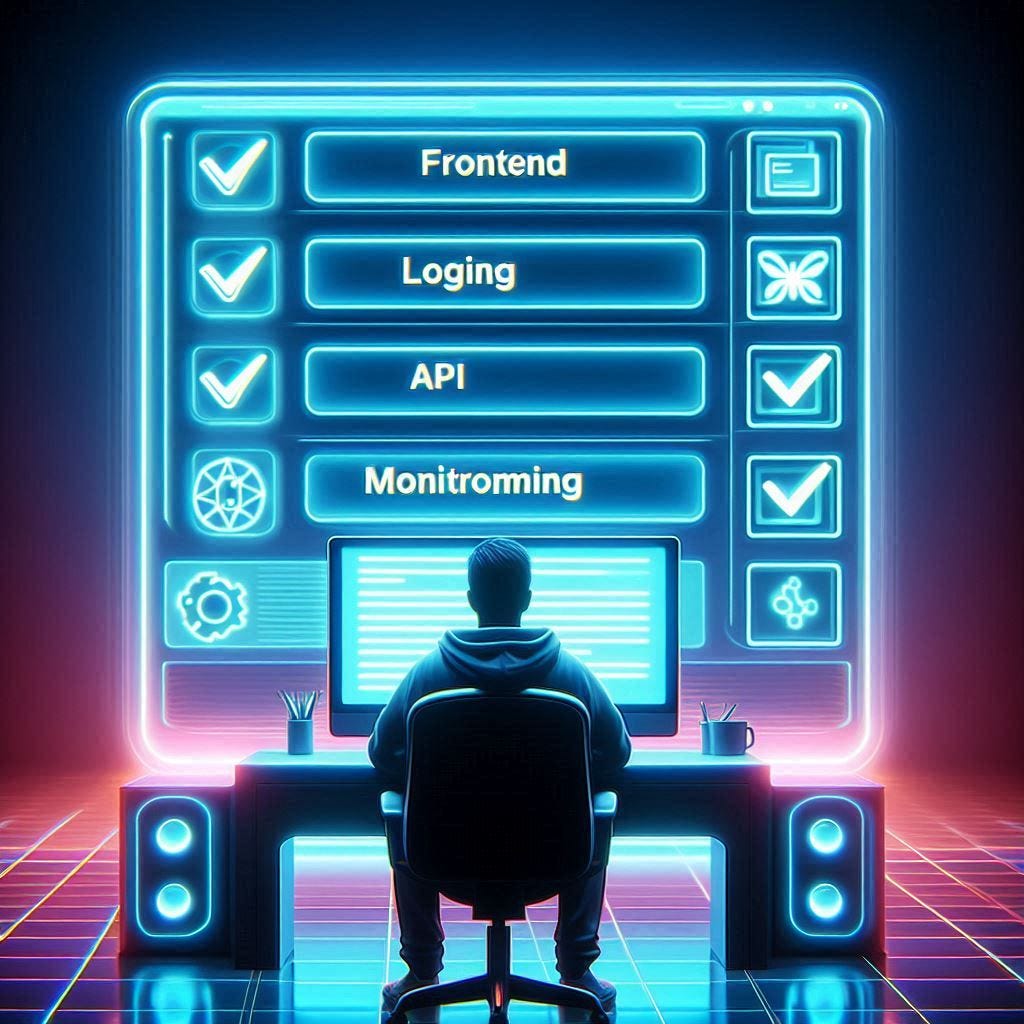🚀 From Code to Cloud: The Only Full-Stack Deployment Checklist You Need in 2025
Skip the chaos. Build, test, deploy — with the F.L.A.M.E. model.
Hey Friends,
Full-stack development is the buzzword recruiters can’t get enough of right now. Over the past few years, I’ve had the chance to ship full-stack apps solo — weather dashboards, multiplayer games, stock tickers, real-time chats… you name it. But even with 12+ years of dev experience, launching end-to-end apps still used to feel overwhelming. 😵💫
Until I built myself a repeatable framework.
Today, I'm sharing it with you — the F.L.A.M.E.🔥 Checklist, built for 2025 and beyond.
It's designed for developers of all levels, especially those trying to break into full-stack roles and wondering, “Where do I even start with deployment?”
Let’s break it down 👇
✅ F.L.A.M.E. Model — Your Full-Stack Deployment GPS
(Frontend · Logging · API · Monitoring · Environment)
🎨 F — Frontend Readiness
Your frontend isn’t “done” just because it works locally.
Let’s make it production-worthy:
Optimize load times: Use tools like Lighthouse to find performance issues. A fast site = happy users.
Bundle smartly: If you’re using React, tools like
ViteorWebpackhelp combine and shrink your files, so users don’t download 10x more than they need.Lazy-load heavy pages: Use
React.lazy()andSuspenseto load only what's needed, when it's needed.Add a content security policy (CSP): Prevent script injection attacks — it’s like putting locks on your house windows. Tools like Helmet in Express or meta tags can help here.
Responsive by default: Use Flexbox/Grid. Test in both desktop & mobile. Use Chrome DevTools device simulation.
🧠 Learning resource: “Designing with Web Standards” by Jeffrey Zeldman – still gold in 2025.
📄 L — Logging Strategy
You won’t know what’s breaking if your app doesn’t talk back.
Here’s how to make sure your app can tell you when something’s wrong:
Use structured logging: Tools like
pinoorwinstonlet you log in a readable, searchable format.Avoid console.log in production: Replace it with structured logs that include timestamps, error levels, and request details.
Don’t log user passwords or personal info — ever. Mask data using built-in log filters.
Test your logs: Break your app on purpose in staging and see if logs catch it. It's better than finding out in production.
📘 Book pick: “Observability Engineering” by Charity Majors will help you think like a DevOps detective 🕵️♂️.
🌐 A — API & Backend Maturity
Your backend isn’t just about “getting data” — it has to be secure, scalable, and smart.
Here’s how to prep your API for production:
Validate everything: Never trust client input. Use
Joi,Zod, or Mongoose schemas to validate incoming data before it hits your database.Rate limit requests: Prevent spam or attacks using
express-rate-limitor built-in API Gateway settings in cloud platforms.Use environment configs: Store secrets like DB passwords in
.envfiles or Azure App Config — never in your code!Auto-generate docs: Use Swagger or Postman to create clean, readable API docs — it’s like an instruction manual for your backend.
Test end-to-end: Tools like
SupertestwithJestcan simulate full request/response flows.
📚 Recommended read: “Designing Web APIs” by Brenda Jin — solid fundamentals for backend engineers of all levels.
🛎 M — Monitoring & Alerts
If a tree falls in your forest of microservices, you should know about it 🌲💥.
Set up tools that watch over your app 24/7:
Uptime monitoring: Free tools like StatusCake or Pingdom ping your site every minute to ensure it’s live.
Client-side error tracking: Use
SentryorLogRocketto know when users hit bugs you didn't test for.Set up dashboards: Use Grafana (free) or Azure Monitor to track CPU, memory, request rates, etc.
Get alerts, not spam: Connect alerts to Slack or email — only for important issues, not every 404.
📊 Idea: Track 4 things in every alert system — Response Time, Error Rate, Traffic, Saturation (RETS). Easy to remember, hard to ignore.
🌍 E — Environment & Deployment
This is where code meets the real world 🌐. Make it smooth, safe, and smart.
Use Docker: Package your app and its dependencies in one container — it runs the same anywhere.
Deploy with CI/CD: Use GitHub Actions or Azure Pipelines to auto-deploy when you push to main — no more “it works on my machine”.
Separate environments: One for dev, one for staging, one for prod. Never test directly in production!
Set up rollbacks: If your new version breaks, you should be able to go back instantly. Use blue-green or canary deployments.
Use platform-ready tools: Try Azure App Service, Railway, or Fly.io — easy to scale and beginner-friendly.
🎓 Lesson: Deployment isn’t the end. It’s where the real game begins.
🔥 Bonus Tip: Preview Environments FTW
Imagine showing your PM or friend a live version of your feature branch before it’s merged — that’s the power of preview deployments (Netlify, Vercel, or GitHub PR Deploys). It's now an industry norm.
📌 The F.L.A.M.E. Checklist helps you:
Think like a production engineer 🧠
Avoid rookie mistakes 🚫
Ship with confidence ✅
Turn it into a Notion doc or pin it to your project README — and revisit it before every launch.
✨ Ace Your Interviews with AceInterviewAI
Excited by frameworks like this? AceInterviewAI is the AI-powered interview coach that is live with an Interactive Question Bank, a live 1:1 tech consultation awaits for you!
🚀 Sign up now for free access!
🔁 Liked the checklist? Forward it to a dev friend.
📬 Want more insights like this?
🎥 YouTube: Let Us Code Together — Real-world project tutorials
"If you want to go fast, go alone. If you want to go far, go together." – African Proverb
Let’s go far — and ship smart.
— Jenifer




